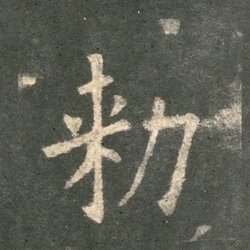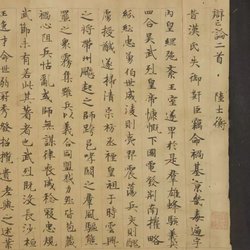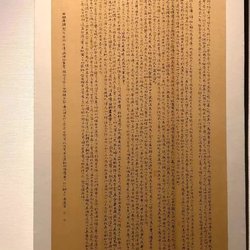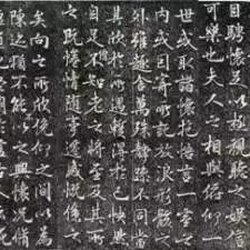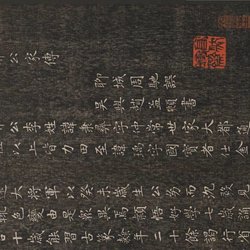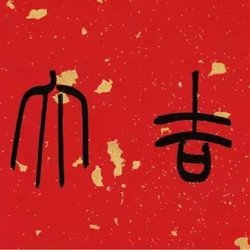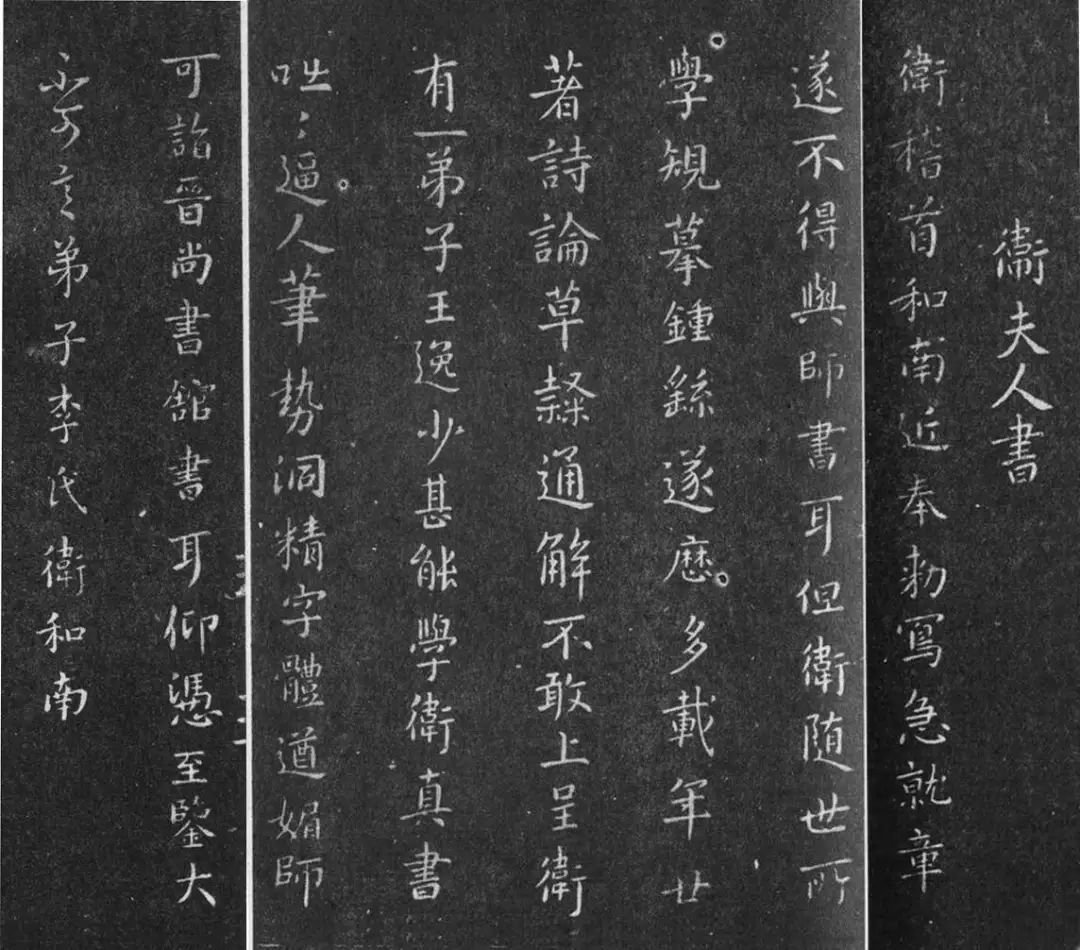
Mrs. Wei's "Jinfeng Tie", also known as "Jishou Henan Tie", is contained in Chunhua Pavilion Tie.
Wei Shuo (272 to 349) female. Her courtesy name was Maoyi, known as Mrs. Wei in the world, and she was a native of Anyi, Hedong (now Suzhuang, Weiguo Township, Xia County). He died in the fifth year of Yonghe at the age of seventy-eight. She is the wife of Li Ju, the prefect of Ruyin. She was born into a scholarly family. The great-granddaughter of the Chinese calligrapher Wei Jian, the granddaughter of Wei Guan, and her uncle Wei Heng are all great calligraphers. Gong Li script and Zheng script (regular script) are especially good at rules. Zhong Yao said: The ice of the jade pot is broken, and the moon of the Yaotai is broken. The trees are graceful and fragrant, and the trees are as soft as the breeze." "Shudaan, Hanmo Zhi".
Regarding her teacher-inheritance relationship, according to the "Book of Fa Shu Yao Lu: Names of Persons Who Instructed the Master", it was said that it was Cui Yuan who was passed down by Cai Yong and Wenji, the daughter of Cai, and Zhong Yao who was passed down by Cai Wenji. It is said that Zhengshu began in the Han Dynasty. In the hands of Zhong Yao, the writing method has become increasingly perfect. He is the ancestor of Zhengshu, and Wei Shuo passed down his method wonderfully. Wei Xu, a Tang Dynasty man, highly praised her in "Mo Sou" and praised her: "Mrs. Wei's book is like a flower-arranging dancer with her hibiscus raised low, like a beautiful woman on the stage with a fairy making her shadow, or like a red lotus reflecting in the water, a green marsh." Fuxia.”
When Wei Shuo was young, he was smart and loved calligraphy. Under his grandfather's personal teaching, he was meticulous in everything from practicing fingering and brushstrokes to displaying strokes and placing them. Paper was difficult to buy at that time, so Wei Shuo often used bricks instead of paper and water instead of ink. From morning to dusk, he would smudge non-stop, even forgetting to eat and sleep, and his hands and arms would ache. Grandfather Wei Guan taught his granddaughter to learn calligraphy in a follow-up and strict manner. If he saw any flaws, he would give guidance or give an example until he was satisfied. Whenever he saw that he had a thorough understanding or progress, he would give high-fives to encourage him, or " "Add circle" reward will push Xiao Weishuo to the top of calligraphy step by step. What is particularly important is that she tried every possible means to obtain Zhong Yao's inscriptions. She strictly followed the order of reading, reflecting, copying and memorizing the inscriptions, carefully comprehending them, practicing repeatedly, deliberately pursuing the truth, and over time, she masterfully taught her method, even to the point of confusing the fake ones with the real ones. . She once wrote Zuo Si's "Sandu Fu" in small regular script, which made Luoyang's paper expensive. She wrote it again and again, and passed it on again and again. She became famous all over the Yangtze River. Xie An praised it and said: "The ice of the broken jade pot, the moon of the ruined Yaotai, the graceful and fragrant trees, the silence is like the breeze." Wei Xu, a Tang Dynasty man, highly praised it in "Mo Sou": "Mrs. Wei's calligraphy is like a dancing girl with skewers, low and low. The hibiscus blooms; it is also like a beautiful woman on the stage, and the fairy goddess makes her shadow; it is also like the red lotus reflecting the water, and the clouds floating on the green marsh."
Wang Xizhi's Shaochang Shi's official writing is wonderful. When he was young, he studied under Wei Shuo and specialized in calligraphy. His skill in using the pen and his spirit of diligently practicing calligraphy came mostly from this enlightening teacher. When Wang Xizhi was twelve years old, his calligraphy improved greatly for a period of time. Mrs. Wei was delighted and felt that Xizhi's rapid progress in calligraphy might have been inspired by a book on calligraphy. She said to Taichang Wang Ce: "This boy must study it." How could he have written so skillfully in such a short period of time?" As expected, Wang Xizhi got a copy of "The Theory of Writing in the Former Dynasty" from under Nai's father's pillow, and then read it carefully, pondered over it, and practiced with concentration. ,improve rapidly. Mrs. Wei greatly praised this and encouraged him to learn from others' strengths and become his own style. Wang Xizhi lived up to Mrs. Wei's teachings. He not only absorbed the essence of the calligraphers of the Han and Wei dynasties, especially Zhong and Wei, but also broke away from their realm to form his own family and was called the sage of calligraphy. Wang Xizhi's son Wang Xianzhi's calligraphy is as good as that of his father, and he is known as the Little Sage. Emperor Wu of Liang Dynasty commented on Wang Xizhi's calligraphy: "Like a dragon leaping over the Tianmen, a tiger crouching in the Phoenix Pavilion." Although blue is better than blue, traces of Mrs. Wei's style are still clearly visible in their calligraphy style.
Mrs. Wei also has unique insights into her calligraphy theory. One of her works, "Bi Zhen Tu", is handed down from generation to generation and recorded in "History of Song Dynasty·Yi Wen Zhi". "Bi Zhen Tu" is a work that discusses writing strokes, explains the methods of holding and using the pen, and lists seven basic stroke writing methods. In "Bi Zhen Tu", she first put forward the theory of "more power and stronger muscles". This is an important innovation. She said: "Those who are good at penmanship have many bones, and those who are not good at penmanship have more flesh. Those who have more bones and less flesh are called sinewers. Those who read more meat and have less bones are called ink pigs. Those who have more strength and tendons are holy, and those who are weak and have no tendons are sick. ." Later, Wang Xizhi also wrote an article "After Mrs. Wei's "Bi Zhen Tu"", further elaborating and developing Mrs. Wei's theory. Sun Guoting of the Tang Dynasty once suspected that the "Bi Zhen Tu" was written by a person from the Six Dynasties in his "Shu Pu", and Zhang Yanyuan's "Fa Shu Yao Lu" was written by Mrs. Wei.
Mrs. Wei's son Li Yun, also known as Zichong, worked as a calligrapher and was also a calligrapher.

